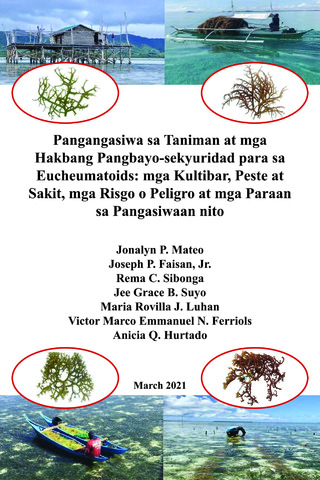Seasonal growth, carrageenan properties, and resistance to disease and epiphytic pests between Kappaphycus alvarezii (Rhodophyta) var. tambalang (brown) tissue-cultured and farm-sourced seaweeds
- Global styles
- MLA
- Vancouver
- Elsevier - Harvard
- APA
- Help

ดู/
วันที่
2024-01-08ผู้เขียน
Page views
267ASFA keyword
AGROVOC keyword
Taxonomic term
Geographic names
เมตาดาต้า
แสดงระเบียนรายการเต็มCited times in Scopus
Share
นามธรรม
Growth performance (specific growth rate [SGR] and biomass yield), carrageenan properties (yield, viscosity, and gel strength), and disease and pest incidence were compared between Kappaphycus alvarezii var. tambalang (brown) tissue-cultured (TC) plantlets and farm-sourced (FS) seedlings. Seedlings used in the trials were propagules (4‒19 g pieces) and these were deployed on lines in sea cages over three separate runs of 60 days. The highest growth rate was recorded in TC plantlets and the SGRs were significantly higher (1.5‒6.5x) in TC than FS after Day of Culture (DOC) 15 (i.e., measurements taken every 15 days in each cycle). The carrageenan properties did not differ between treatments, with the exception of viscosity at DOC 45, where TC was higher than FS. “Ice-ice” disease (IID) was observed in both FS and TC in May‒June and August‒October at DOC 45 to 60, coinciding with changes in environmental conditions (i.e., dry‒wet and wet seasons). IID in FS had a moderate to very high incidence (31.2‒86.2%), while TC IID had a lower range of incidence (12.8‒60.6%). On the other hand, epiphytic filamentous algae (EFA) were observed only in August‒October with a low incidence (≤25%). However, EFA appeared earlier in FS than in TC. Taken together, these results highlight that tissue-cultured seaweeds had higher growth performance without compromising carrageenan quality and may be more resistant to health problems than farm-sourced seedlings. Studies should now assess the long-term viability of using tissue-cultured seaweeds over farm-sourced seedlings scaling to allow testing in standard farm settings, including the size of the initial seed.
การอ้างอิง
Faisan, J., Joseph, Samson, E. J. D., Sollesta-Pitogo, H., Dayrit, R., Balinas, V. T., & de la Peña, L. D. (2024). Seasonal growth, carrageenan properties, and resistance to disease and epiphytic pests between Kappaphycus alvarezii (Rhodophyta) var. tambalang (brown) tissue-cultured and farm-sourced seaweeds. Journal of Applied Phycology , 36(3), 1377-1389. https://doi.org/10.1007/s10811-023-03164-z
Type
ArticleISSN
0921-8971; 1573-5176คอลเลกชัน
- Journal Articles [1229]
Related items
Showing items related by title, author, creator and subject.
-
Farm management and biosecurity measures of Eucheumatoids: Cultivars, pest and disease, risks and risk managements
This brochure was prepared and written after four years of research of the seaweed industry of the Philippines by the GlobalSeaweedSTAR Philippine Team in a layman’s language. This provides the different stakeholders of ... -
Biyah diin in pagparagan sin pagtanuman agal agal iban pag'ayad ha pag' urulan sin kabuhi: Binhi atawa tanumun agal agal, manga mangangaun iban kumakangii' iban sakit, manga anib atawa makamula' iban biyah diin in pagpahilunnah sin anib atawa piligru ha pagtanum agal agal
In buwk-buwk pahati ini nahinang iban kiyasulat paglabay upat tahun ha pagsaliksik ha pag’usaha agal agal ha Pilipinas hinang sin tumpukan sin GlobalSeaweedSTAR Philippine ha bitsara kahatihan sin kamatauran. Makatagama ... -
Pangangasiwa sa taniman at mga hakbang pangbayo-sekyuridad para sa Eucheumatoids: Mga kultibar, peste at sakit, mga risgo o peligro at mga paraan sa pangasiwaan nito
Ang polyeto na ito ay inihanda at isinulat ng GlobalSeaweedSTAR Philippine Team sa payak na lengwahe matapos ang apat na taong pananaliksik sa industriya ng pag-aalaga ng mga halamang-dagat sa Pilipinas. Nais nito na ...







